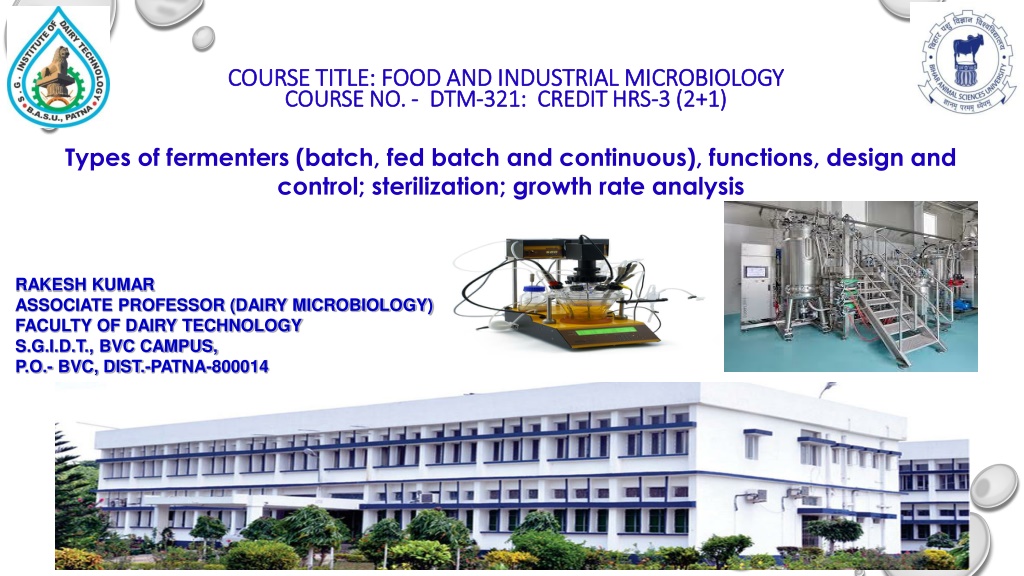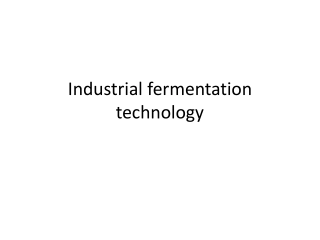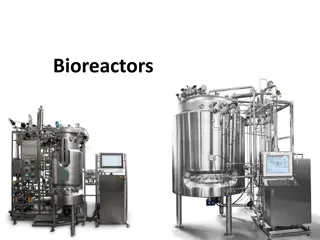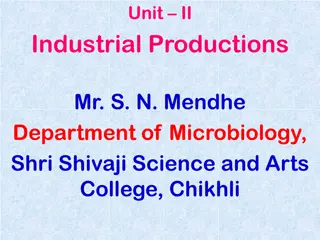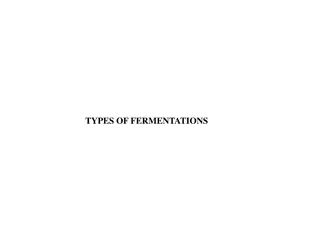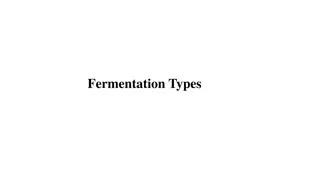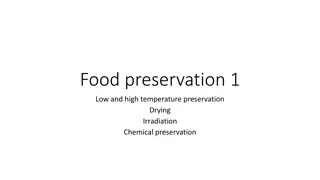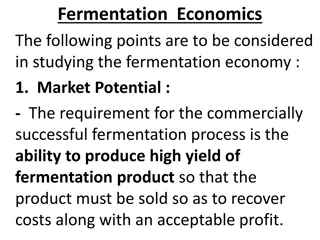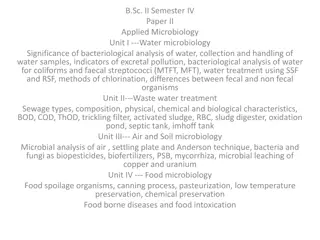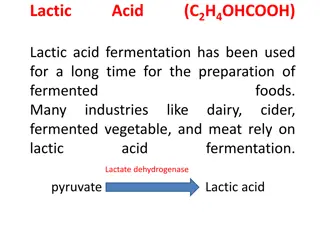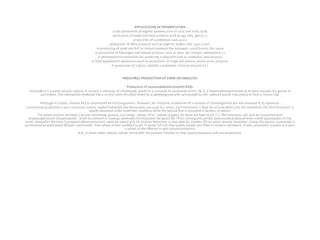Understanding Fermentation and Bioreactors in Food and Industrial Microbiology
Fermentation is a crucial process where substances break down into simpler forms using organisms, generating energy. Bioreactors are systems supporting biochemically active environments for specific organisms, either aerobic or anaerobic. Learn about the history, importance, and applications of fermentation and bioreactors in the food and industrial microbiology field.
Download Presentation

Please find below an Image/Link to download the presentation.
The content on the website is provided AS IS for your information and personal use only. It may not be sold, licensed, or shared on other websites without obtaining consent from the author. Download presentation by click this link. If you encounter any issues during the download, it is possible that the publisher has removed the file from their server.
E N D
Presentation Transcript
COURSE TITLE: FOOD AND INDUSTRIAL MICROBIOLOGY COURSE TITLE: FOOD AND INDUSTRIAL MICROBIOLOGY COURSE NO. COURSE NO. - - DTM DTM- -321: CREDIT HRS 321: CREDIT HRS- -3 (2+1) 3 (2+1) Types of fermenters (batch, fed batch and continuous), functions, design and control; sterilization; growth rate analysis RAKESH KUMAR ASSOCIATE PROFESSOR (DAIRY MICROBIOLOGY) FACULTY OF DAIRY TECHNOLOGY S.G.I.D.T., BVC CAMPUS, P.O.- BVC, DIST.-PATNA-800014
Fermentation Fermentation is the process in which a substance breaks down into a simpler substance using organism. Its biochemical meaning relates to the generation of energy by the catabolism of organic compounds. Fermentation is a word that has many meanings for the microbiologist: 1. Any process involving the mass culture of microorganisms, either aerobic or anaerobic. 2. Any biological process that occurs in the absence of O2.
Bioreactor is a device or system in which a chemical process is carried out that supports to maintain a biologically active environment inside that vessel which involves biochemically active substances derived from specific organisms. This process may either be aerobic or anaerobic. These bioreactors cylindrical in shape ranging in size from litres to cubic metres and are often made up of stainless steel material. organisms or are commonly Fermentation system / process objectives depends on two factors: Fermentor design and Fermentation process Source: https://en.wikipedia.org/wiki/Bioreactor
The process of fermentation has been known for thousands of years, but has been mainly based on the glucose found in various fruits, seeds and tubers into alcohol, later used for human consumption. In recent times fermenter simply provide an optimal environment for bacteria and / or fungi to grow in and the cultivation of said organisms will yield a desirable substance. Organisms growing in bioreactors may be submerged in liquid medium or may be attached to the surface of a solid medium. Submerged cultures may be suspended or immobilized. Suspension bioreactors can be used for a wider variety of organisms, since special attachment surfaces are not needed and can operate at a much larger scale than immobilized cultures. However, in a continuously operated process the organisms will be removed from the reactor with the effluent. Immobilization is a general term describing a wide variety of methods for cell or particle attachment or entrapment. It can be applied to basically all types of biocatalysts including enzymes, cellular organelles, animal and plant cells. Immobilization is useful for continuously operated processes, since the organisms will not be removed with the reactor effluent but it is limited scale because the microbes are only present on the surfaces of the vessel.
A typical bioreactor consists of following parts: Agitator used for the mixing of the contents of the reactor which keeps the cells in the perfect homogenous condition for better transport of nutrients and oxygen to the desired product(s). Baffle used to break the vortex formation in the vessel, which is usually highly undesirable as it changes the center of gravity of the system and consumes additional power. Sparger In aerobic cultivation process, the purpose of the sparger is to supply adequate oxygen to the growing cells. Jacket The jacket provides the annular area for circulation of constant temperature of water which keeps the temperature of the bioreactor at a constant value.
On the basis of mode of operation, a bioreactor may be classified as batch, fed batch or continuous (e.g. a continuous stirred-tank reactor model)
Batch cultivation is closed system where there is no interaction between the system and the surrounding during the process. Except air during the aerobic cultivation. In Batch cultivation we prepare medium, sterilize it and inoculate the culture into the bioreactor. Allow the cells to grow and produce the product. Once the product formation reaches to maximum harvest the fermentation broth. How cells grow during Batch cultivation After inoculating the medium and start measuring the biomass at different time intervals, you may find six different phases intervals. They are as follows-- Lag phase Accelerated growth phase Exponential growth phase Decelerated growth phase Stationary phase Death phase
Lag Phase Lag Phase is an initial period of cultivation during which the change of cell number is zero or negligible. Even though the cell number does not increase, the cells may grow in size during this period. The Lag phase results from several factors. When cells are placed in the fresh medium, the intracellular concentrations of cofactors, amino acids, ions will decrease and these have to be synthesized / transported first before cell division to occur. When the cells are inoculated into medium containing different carbon source then the enzymes for its metabolism have to be transported. When cell are placed in medium containing several carbon sources then several lag phases may result. This is known as diauxic growth. This is known as diauxic growth. When glucose and lactose are present then glucose will be utilized first then lactose. Presence of glucose will have catabolite repression on galactosidase enzyme which is required for lactose utilization.
How to avoid lag phase --- Lag phase is non productive period in the industrial fermentations. Hence industrial fermentations minimizing it is essential. The stage of culture from where the stage of culture from where the inoculum is drawn is important. Exponentially growing cells will have adequate concentrations of intermediates and intracellular pool of compounds. Hence if the inoculum is drawn from this stage they will not suffer dilution effect. Size of the inoculum If the size of the inoculum is large then the lag phase can be minimized. Generally 10% are used for yeast and mold and 5% for bacteria. Medium of inoculum should be same of that production medium. Accelerated growth phase ---- At the end of Lag when growth begins the division rate increase gradually and reaches a maximum value. The growth rate increases to maximum during this phase.
Exponential growth phase --- Cell division occurs in this phase. Often cell dry weight is used for cell concentration. Stationary Phase --- In this phase, the growth i.e., cell division, almost ceases due to exhaustion of nutrients and also the accumulation of toxic products. At this stage the cell death starts at a slow rate and is compensated by the formation of new cell through cell division.The total cell number increases at a slow rate, but the viable count remains almost constant. The duration of this phase is variable which ranges from few days to few hours. Secondary metabolites like antibiotics, toxins etc. are produced in this phase. Decline Phase ---- In the phase of decline, the total number of cells remains constant, but the number of viable cells gradually decreases due to exhaustion of nutrients and also the accumulation of toxic products. In some cases a few- cells remain viable for long time, even after death of most of the cells. These viable cells probably grow by utilizing nutrients released from dead cells. The cells attain maximum size at the end of lag phase and become smaller in log phase (exponential phase). In spore forming species, the sporulation occurs at the end of log phase (exponential phase) or in the early part of stationary phase.
Micro-organisms used for fermentation process grow on or in growth medium which satisfies the nutritional needs of microbes. Complete analysis is needed to be done to establish the most favourable medium for the growth of the microbe used for fermentation. Formulating medium at lab scale can be done by adding main ingredients like water, carbon source, nitrogen source, minerals and other supplements in pure form and in required quantities is very easy which supports the growth of the microbe whereas, the same may not support the satisfactory growth of the same organism at industrial level. Following criteria need to be satisfied for the material to be treated as medium at industrial level -- It should give maximum yield of product. It should give minimum yield of undesired product. It should be consistently available throughout the year. It should be cheap.
NUTRIENTS Most fermentations require liquid media, often referred to as broth; although some solid substrate fermentations (SSF) are operated. Fermentation media must satisfy all the nutritional requirements of the microorganism and fulfil the technical objectives of the process. All microorganisms require water, sources of energy, carbon, nitrogen, mineral elements and possibly vitamins plus oxygen if aerobic. The nutrients should be formulated to promote the synthesis of the target product, either cell biomass or a specific metabolite. In most industrial fermentation processes there are several stages where media are required. They may include several inoculum (starter culture) propagation steps, pilot scale fermentations and the main production fermentation. The technical objectives of inoculum propagation and the main fermentation are often very different, which may be reflected in differences in their media formulations.
Batch culture technique Batch culture technique is also called as closed system of cultivation. In this technique at first nutrient solution is prepared and it is inoculated with inoculum (culture organism) and then nothing is added in the fermentation tank except aeration. In batch culture, neither fresh medium is added nor used up media is removed from the cultivation vessel. Therefore volume of culture remains same. Since fresh media is not added during the course of incubation, concentration of nutrition decreases continuously. Furthermore various toxic metabolites also accumulates in the culture vessel. Therefore batch culture technique gives characteristics growth curve with lag phase, log phase, stationary phase and decline phase. Advantage: Chance of contamination of culture is minimum in batch culture technique because it is closed system of cultivation. Disadvantage: It gives low product yield and it is not economic procedure.
Fed-batch culture technique: Fed-batch culture is also called as semi-closed system of cultivation. In this technique, at first nutrient media is prepared and it is inoculated with culture organism and then incubated for particulate time. During the course of incubation a particular nutrient is added at intervals without removing the used up media.so the volume of culture increases continuously. Fed batch culture technique is applied in many types of fermentation process. In fermentation some nutrient is very essential for the process but when these nutrients are provided in higher concentration in the culture they inhibit the growth of bacteria ultimately ceasing the fermentation. Therefore such nutrients are kept in lower concentration initially and it is added slowly and continuously during the course of fermentation. Advantage: Fed batch culture gives greater product yields than batch culture technique. Disadvantage: Chance of contamination of culture is higher in fed-batch than batch culture technique.
Continuous culture technique Continuous culture technique is also called as open system of cultivation. In this technique fresh sterile medium is added continuously in the vessel and used up media with bacterial culture is removed continuously at the same rate. So the volume and bacterial density remain same in the cultivation vessel. In this technique, bacteria grow continuously in their log phase. This type of growth is known as steady state growth. The cell density in continuous culture remains constant and it is achieved by maintaining constant dilution and flow rate. Continuous culture is important in industrial processes that harvest the primary metabolites of micro-organisms as their products. (Primary metabolites are produced in greatest quantities when the organisms are growing at their fastest rate). A culture vessel designed for continuous culture and two types of approaches can be adopted in continuous culture method --- i. Chemostat ii. Turbidostat
Advantages of continuous culture It can be carried out in smaller vessels (productivity high). The high productivity for biomass and intra- and extra-cellular enzymes is more cost effective Disadvantages of continuous culture Microbial growth, clumping of cells and foaming tend to block up inlet pipes. Can be difficult to control all the environmental factors could lead to considerable amount of waste. Not possible to create the low-nutrient, high-stress conditions under which secondary metabolites such as penicillin are produced. Batch Culture Continuous Culture Thank You
